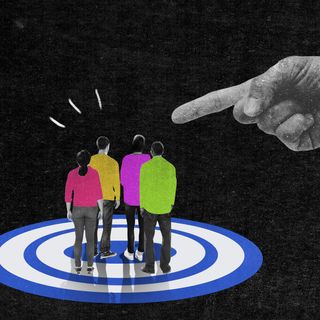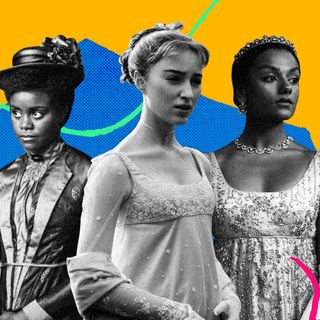
The Enduring Power of Clichés, Explained
Clichés have earned a bad rep, but they reflect essential truths familiar to all of us.

I have a friend who speaks only in trite, pithy statements — “What goes around comes around.” “You should really think outside the box.” “Maybe you woke up on the wrong side of the bed.” No? “Then it feels like a perfect storm.” God, they’re “such a cliché.”
To their chagrin, these nifty little sayings are cast away in a linguistic shadow. Clichés are denounced as boring, overused, banal; some would even argue they reinforce a culture of conformity and water down discourse. A cliché is anything but unique; redundant at best, meaningless at worst.
But at the end of the day, these buzz-words make their way into our conversations perniciously. It’s like a linguistic habit that is grievously hard to shake. This belies a truth at the heart of the language: clichés are clichés for a reason. Their claim to power is found in familiarity, universal truths, and creating a sense of camaraderie.
By definition, a cliché is meant to be unoriginal and unsophisticated. The word originated mid-19th century in France; it meant to product or print in “stereotype.” A stereotype was a printing plate used to put together versions of the same design — like assembling letter blocks from commonly figuring word combinations. The stereotype would tut forth a “clicking” sound, giving birth to “cliché.” And by the end of the 19th century, cliché came to define repetitions and overuse — much like the printing plates. To hate cliché by virtue of its repetition is to hate water for being liquid or fire for being too hot; it’s in a cliché’s nature to be agile, to drip off the tongue and memory with ease.
It also helps to think of how these phrases exist within language. Language is powerful and dynamic; within the pandemic in itself, words entered our lexicon, indicating cultural shifts of very modern reality. In the backdrop of this ever-morphing sea of words, bromides that are passed down generations of people — as armors against struggle, joy, grief — carry inexplicable power. When thinking of “what doesn’t kill you makes you stronger,” writer Hephzibah Anderson notes: “The very fact that it has been repeated down the generations gives you strength because, you know, it makes you think, well, you know, I’m not in this alone, people have done this before.”
There is a truthfulness between the obsolescence; that something so old and generic can be applied individually today speaks of the universal truth within these. “If these truths can stick with us, they’re there for a reason.”
Related on The Swaddle:
Mindy Kaling’s ‘Never Have I Ever’ Caricatures Indianness, Glorifies Clichés
Then there is alsoa strong sense of camaraderie that comes with using these words. Nothing is new but also everything is, and here are some words to help you tide over these familiar waves.
Arguably, there are good clichés and bad ones. Bad ones would be those that mean absolutely nothing and exist as mere punctuations in a sentence. “Those are things you can strip from any sentence, and the sentence will be absolutely none the worse,” Anderson says. Templatized formulas for success — like “When the going gets tough, the tough get going” — are arguably better pushed into retirement.
“But the really good clichés are — in my opinion… the ones that are packed with color and wonderful images, even though we often hear them so often, so frequently that we don’t pause to consider them.” Think “elephant in the room” or “back to the drawing board.” Or, “when it rains it pours.” It’s a poetic language of its own.
And to think of the history embedded within these catchphrases and expressions. Ever wonder how “Better late than never” came into being? Greek historian Dionysius of Halicarnassus first coined it. “Cut to the chase” originated from a 1930 film Show Girl in Hollywood as a cue in the screenplay. “Thinking outside the box” found its way into common parlance from the 1970s; when an aviation trade magazine use was among the first recorded ones.
One has to commend how incredibly adaptable a cliché is. That it can be used in multitudes and by multitudes lends it unparalleled survival. One may not know what “castles in Spain” look like or how wonderfully rich “a drop in the ocean” really is — but it’s comforting to know that words have such power to construe an image without fail.
In some ways, clichés also carry a comforting tinge of familiarity. We know the brain is attracted to predictability; psychologists coined the term “familiarity bias” to reflect the human tendency to favor known things over novel people, places, or experiences. The same arguably applies to our choice of words too — we’re more likely to use words by virtue of their easy availability in our memory and thus favor them because they are so familiar to us. Even beyond what the psyche prefers, being familiar anecdotally with an old chestnut (like “they lived happily ever after” or “all that glitters is not gold”) makes it easier to understand broad strokes of truths.
A cliché, in words dripping with repetition, shapes a common understanding. “They are the instruments through which a ‘common-sense’ view of life is disseminated. Pithy aphorisms play a central role in the transmission of beliefs. They serve as conduits through which psychological concepts flow into the broader culture,” wrote Steven Mitz, a professor of history at the University of Texas at Austin. Clichés can, then, also act as segues into critiquing the kind of assumptions we make about ourselves and the world.
Maybe a cliché derives its power from people’s disdain. Instead of eschewing their worth, it’s time to look at them from the lens of a shared culture; their enduring power perhaps lies in collectivism and comfort.
Sometimes, only words we’ve heard and re-heard to a point of exhaustion offer comfort. And sometimes, when all else fails, clichés can be cushions of knowledge, telling tales of the past and present.
Saumya Kalia is an Associate Editor at The Swaddle. Her journalism and writing explore issues of social justice, digital sub-cultures, media ecosystem, literature, and memory as they cut across socio-cultural periods. You can reach her at @Saumya_Kalia.
Related


How Historical Fiction on TV Rewrites Race – For Better and for Worse
